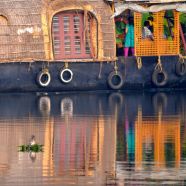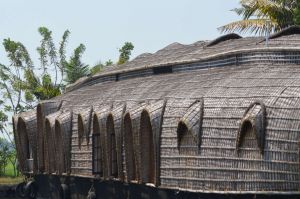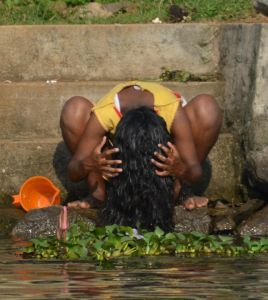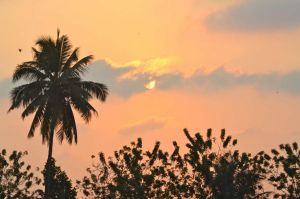Cooling Off the Sultry Backwaters: A Passage
“Travel makes one modest. You see what a tiny place you occupy in the world.” Gustave Flaubert
The three men came as a package. Crew on the honeymoon houseboat I’d rented for the night in South India’s Alleppey, one would steer us through the famous backwaters, while another would prepare local dishes, and a third would both spell the oarsman and keep me company. This trip, I told myself, would be one of those highlights I envisaged when I launched on my year of global wanderings in May 2011, forsaking the comfort and familiarity of my Chatham County, North Carolina, home for the vagaries of artist residencies around the world. More than Italy, France, or Turkey, it was the prospect of exotic India that thrilled me the most. For three-plus months I would roam the subcontinent from Dharamsala in the Himalayan foothills in the far north to Kerala, a southern scrap of land between the Arabian Sea and the Western Ghats.
As things turned out on that houseboat, with the crew’s lack of English, and mine of Malayalam, the region’s unique and mellifluous lingo, we would converse little and gesture much. Conditions for misadventure were ripe.
Coastal Kerala is especially hot and humid this time of year—the heavy air barely twitches in the sporadic breeze. Relief comes only in June with the Southwest Monsoon, first of Kerala’s two big yearly rainfalls. But this was mid-February, and the blue sky gave little hint of the summer downpours that would soon replace sun-seeking Westerners with rain-starved and desert-weary Arabs.
Our houseboat, with its single bedroom, outdoor galley, and canopied deck, glided past stock-still snowy egrets dotting paddies of Kerala rice, a plump and tasty grain tailor-made for fish curry and other regional dishes. Agriculture long ago transformed the dense forests into spice and rubber plantations, tea gardens (further west) and coconut groves. The region’s name comes from the Malayalam for coconut—kera—and while this tropical fruit is key to South Indian cuisine, its palm is also fermented into toddy, an alcoholic drink sold at roadside shacks, and its dried husks burned to charcoal for household irons.
Black pepper was the first spice to draw outsiders to Kerala—Phoenicians, Arabs, Egyptians, Greeks, and Romans found they could fairly breeze over with that first southwesterly monsoon and return with the second, its northwest winds blowing them home in late autumn with the highly prized Malabar and Thalasseri varieties, much of which ended up in Europe. I had earlier wandered the still-bustling spice markets of Fort Kochi, Kerala’s ancient port, where sacks of black pepper, turmeric, ginger, cardamom, cinnamon, cloves, and dried tea still wait for ships to carry them far and wide. Warehouses and homes built by Portuguese then Dutch and British colonialists continue to line Fort Kochi’s narrow streets and alleys.
My favorite site in Fort Kochi was the Chinese Fishing Nets, introduced around the 1300s and still used today. These huge nets are strung artfully between wooden poles and suspended over the water from platforms constructed on the beach. They are raised and lowered by cantilevers and ropes balanced with huge stones, re-emerging from the sea, especially during monsoons, with tons of shiny fish. Stock was minimal this February, but even the small catch drawn up to delight the tourists showed what this centuries-old technology could do.
Kerala’s backwaters—fresh far from the sea, brackish near—also boast fish, and our houseboat passed many a hopeful man hovering over the surface with a crossbow or homemade rod. Some glanced up with annoyance as our passing no doubt startled the evening meal. Most houseboats these days ferry camera-toting and even hard-drinking tourists rather than the families that once called them home. Still, women bathed openly nearby—some crouching on banks to wash long, black hair and others standing waist-deep to scrub pots and pans or rhythmically slap wet laundry against the stones, the sound resonating up, down, and across the ripples.
Daily life in South India tends to be friendlier and more relaxed than up north, especially in the big cities of Jaipur and Delhi where denser populations, fierce competition, and the lure of riches keep people racing through the crowded streets. But South India’s high temps and humidity make such running around next to impossible and, instead, slow down conversations and invite more conviviality and contemplation. This is not to say South Indians ignore opportunities to make money—Fort Kochi is a tourist magnet, and locals have figured out how to price and sell everything from spice packets to cooking classes and Ayurvedic massage. It’s just that the marketing spiel is more charming and subtle. I should know; having sworn up and down I would not be lured into buying a carpet, I eventually, of course, did.
India is well known as a spiritual mecca and Kerala perhaps even more so. The backwaters are lined with brightly colored Hindu shrines and Christian churches as well as the occasional mosque and Buddhist compound—Jewish synagogues, built for the merchants who were powerful players in the early days of trade, are more prevalent in Kochi. Hindus dominate in Kerala, followed by Muslims and Syrian Christians—the latter trace their spiritual lineage to St. Thomas the Apostle and his visit to India in the first century CE.
It was impossible not to notice how well the different religions seem to get along. While Muslims and Hindus keep fighting over the northern state of Kashmir, they peacefully cohabitate in Kerala. In my three-man crew, as if to prove the point, we had a Christian, Hindu, and Muslim. Despite our language barrier, I managed to glean that much information from them, and despite different faiths, they had been working together for years and honed their teamwork to perfection. Perhaps this is why Kerala bills itself as “God’s Own Country”?
In the pink fading daylight on the houseboat, as the sun dipped below palm trees to the west, a long-necked bird plucked small fish out of the water and swallowed them. The bird reminded me of the Anhinga, found throughout America’s southernmost states, and I later discovered it was indeed a relative—the Indian Darter.
* * *
At their height, Kerala houseboats, or kettuvallam, could carry up to thirty tons of rice, spices, and other products harvested around this lowest lying region of India to the ports of Fort Kochi and its modern neighbor, Kochi. Many kettuvallam are more than a hundred years old and once plied all one thousand miles of these natural and manmade canals connecting forty-four rivers, lagoons, and lakes. The boats—some new but most reconfigured for leisure since trucks now transport their former cargo—are assembled without nails; rather, jackwood planks are laced together with knotted coir, a natural coconut fiber, and coated with black resin from boiled cashew kernels. Over time, the jackwood takes on the warm patina of mahogany. What make these houseboats even more picturesque are the bamboo mats shaped and rounded over the roof and around the windows, creating a lovely undulating and sensuous effect.
Because serious fishermen work these waters at night, the houseboats turn off their small engines from dusk till dawn. We pulled up beside other kettuvallam and loosely tied the bow and stern to trees along the riverbank. As the chef prepared the evening meal out back, I hoped he would spare me a feast as copious as lunch. Used to cooking for two hungry guests, he had put on my table enough for four. I could not get the crew to join me, and instead they kept piling on the crispy prawns; thick dal; sautéed potatoes; chapatti; Kerala rice; lightly fried whole fish; a salad of sliced raw carrots, tomatoes, and onion; pineapple; and tapioca pudding for dessert. They disapproved when I shook my head and patted my stomach—no more, I said to deaf ears. I could only hope they ate the remainder themselves, or would distribute it to villagers nearby. In a country where so many remain so poor, I couldn’t bear the thought of my meal going to waste. That said, I didn’t want it going to my waist, either.
While waiting for dinner, one of the men offered to take me for a walk along the narrow banks that stretched far back from the river. Though an American in Kerala for the first time, I felt little trepidation. Traveling alone in India for five weeks by then, I’d met many good and like-minded Indians, and felt safer than I might in parts of the States. I mostly feared for my pocketbook; India is no longer the bargain it used to be, and even the most seasoned world traveler will get the short end of the stick in financial interactions—Indian merchants are remarkably deft at separating tourists from their cash. I found that out when purchasing the rug. My houseboat with crew cost 7000 rupees or about $125 for one night and three meals.
Strolling past the backwater denizens—men, women and children, some swimming, others smoking—I noticed glances that seemed amused, confused and occasionally hostile. But houseboats dock here every night, I told myself, so I couldn’t be the first blondish woman they’d ever seen. I finally got an answer from my companion—in my long white tunic, white capri pants, and two strands of dark Hindu beads, I was dressed like a swami. Was I a swami, or did I think I was? They’d asked him in Malayalam. Fortunately, most seemed to find the idea more entertaining than offensive. I laughed my head off at the thought.
* * *
On returning to the boat, I saw a tall pole with a long fluorescent-style light about thirty feet away. The bulb was attracting swarms of flies, mosquitoes, and I don’t know what else. As the word got out, more insects flocked to its brightness and the mob grew noisy and thick. I’d decided not to take Malarone, as Kerala prided itself on having eradicated malaria even in the swamps. And I had just come from the tea gardens on the edge of the Western Ghats where mosquito-borne diseases have also long since disappeared. Worries about malaria in Kerala have been replaced by concerns about the effects of this ever-increasing tourism, fueled so easily by such attractions as the fishing nets and kettuvallam. As India modernizes and caters to demanding Westerners and monied Indians, it’s hard not to share those concerns about tourism’s impact on traditional ways of life. So many of the young people long for an MBA and possible escape to Europe or the States. Kerala enjoys almost 100 percent literacy, and even children of working-class parents are sent to private schools with the hope of becoming more than a driver or fisherman. That said, I was astonished to see the red-and-yellow hammer and sickle flying along the riverbanks. The communist party is alive and well in Kerala, and occasionally even runs the government. Locals say it was communist policies that pushed the literacy rate so high.
Dinner ended up being lavish, and again I protested to no avail. Riverside lights twinkled in the darkness as darters dove for a final bedtime snack. By the door of my bedroom, the chef pointed to the big air conditioner hanging in a corner and explained in so many words that its temperature setting could not be changed by anyone but him. If I needed to adjust it, I would have to ask. I thought nothing of it, and was moderately relieved not to spend the night in a broiling hot room with windows closed against the bugs. I have, after all, spent nearly twenty years in the air-conditioned American South.
Before I turned out the light, my travel clock noted the space was a comfortable 75 degrees. Under my thin sheet, I reflected on finding myself in South India and the luxury of puttering ever so slowly through these peaceful backwaters. With my next destination Northern Iceland, I reminded myself to enjoy the intense warmth and greenery. Twenty minutes later, my clock’s thermostat was down to 70 and an hour later nearly 60. I doubled the bed cover and piled on every towel plus large pieces of clothing from my suitcase. Soon, it had fallen to 55. I started to panic. At this rate, the tiny room would be fit just for freezing prawns by midnight. I went in search of the chef, only to find him and his cohorts asleep on the prow. In the buggy dark. Snoring.
“Hello?”
Nothing.
“Hello?”
Should I nudge them? Give them a kick? I had no idea which of them was lying where.
“Hello!”
Any louder and I would wake up the whole village. The trio snored on.
I retreated to my room and threw open the windows. Cold air rushed out while the blessed warmth wandered in. Soon, I knew, the bugs would follow. After slathering on repellent, I watched them dart overhead in frustration. The air conditioner chugged away in its misguided attempt to turn the steamy Kerala backwaters into a polar ice cap. Hoping no one would notice this environmental faux pas, I pulled up my light blanket again and fell fast asleep.











I liked what I read, and need more.
Keep me posted will yeah!
Thank you, Conrad. I’ll do my best!
Very interesting and enjoyable reading! Is there anywhere else I can read about your travels?
Thanks for your kind comment, Nancy. I’m so glad you enjoyed my, um, misadventures in Kerala. I’m just now getting into travel writing, so, apart from two kids’ travel guides to Paris and Philadelphia — published years ago — I have yet to write much else in that genre. But thank you for your interest and encouragement!